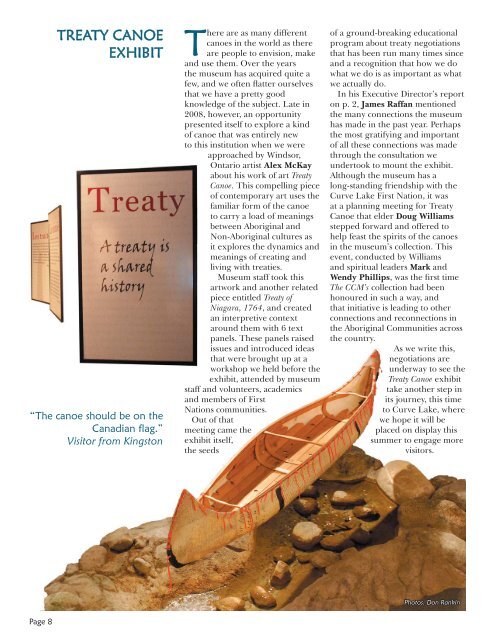Celebrating Our National Treasure - Canadian Canoe Museum
Celebrating Our National Treasure - Canadian Canoe Museum
Celebrating Our National Treasure - Canadian Canoe Museum
You also want an ePaper? Increase the reach of your titles
YUMPU automatically turns print PDFs into web optimized ePapers that Google loves.
Page 8<br />
TREATY CANOE<br />
EXHIBIT<br />
“The canoe should be on the<br />
<strong>Canadian</strong> flag.”<br />
Visitor from Kingston<br />
There are as many different<br />
canoes in the world as there<br />
EXHIBIT are people to envision, make<br />
and use them. Over the years<br />
the museum has acquired quite a<br />
few, and we often fl atter ourselves<br />
that we have a pretty good<br />
knowledge of the subject. Late in<br />
2008, however, an opportunity<br />
presented itself to explore a kind<br />
of canoe that was entirely new<br />
to this institution when we were<br />
approached by Windsor,<br />
Ontario artist Alex McKay<br />
about his work of art Treaty<br />
<strong>Canoe</strong>. This compelling piece<br />
of contemporary art uses the<br />
familiar form of the canoe<br />
to carry a load of meanings<br />
between Aboriginal and<br />
Non-Aboriginal cultures as<br />
it explores the dynamics and<br />
meanings of creating and<br />
living with treaties.<br />
<strong>Museum</strong> staff took this<br />
artwork and another related<br />
piece entitled Treaty of<br />
Niagara, 1764, and created<br />
an interpretive context<br />
around them with 6 text<br />
panels. These panels raised<br />
issues and introduced ideas<br />
that were brought up at a<br />
workshop we held before the<br />
exhibit, attended by museum<br />
staff and volunteers, academics<br />
and members of First<br />
Nations communities.<br />
Out of that<br />
meeting came the<br />
exhibit itself,<br />
the seeds<br />
of a ground-breaking educational<br />
program about treaty negotiations<br />
that has been run many times since<br />
and a recognition that how we do<br />
what we do is as important as what<br />
we actually do.<br />
In his Executive Director’s report<br />
on p. 2, James Raffan mentioned<br />
the many connections the museum<br />
has made in the past year. Perhaps<br />
the most gratifying and important<br />
of all these connections was made<br />
through the consultation we<br />
undertook to mount the exhibit.<br />
Although the museum has a<br />
long-standing friendship with the<br />
Curve Lake First Nation, it was<br />
at a planning meeting for Treaty<br />
<strong>Canoe</strong> that elder Doug Williams<br />
stepped forward and offered to<br />
help feast the spirits of the canoes<br />
in the museum’s collection. This<br />
event, conducted by Williams<br />
and spiritual leaders Mark and<br />
Wendy Phillips, was the fi rst time<br />
The CCM’s collection had been<br />
honoured in such a way, and<br />
that initiative is leading to other<br />
connections and reconnections in<br />
the Aboriginal Communities across<br />
the country.<br />
As we write this,<br />
negotiations are<br />
underway to see the<br />
Treaty <strong>Canoe</strong> exhibit<br />
take another step in<br />
its journey, this time<br />
to Curve Lake, where<br />
we hope it will be<br />
placed on display this<br />
summer to engage more<br />
visitors.<br />
Photos: Don Rankin



